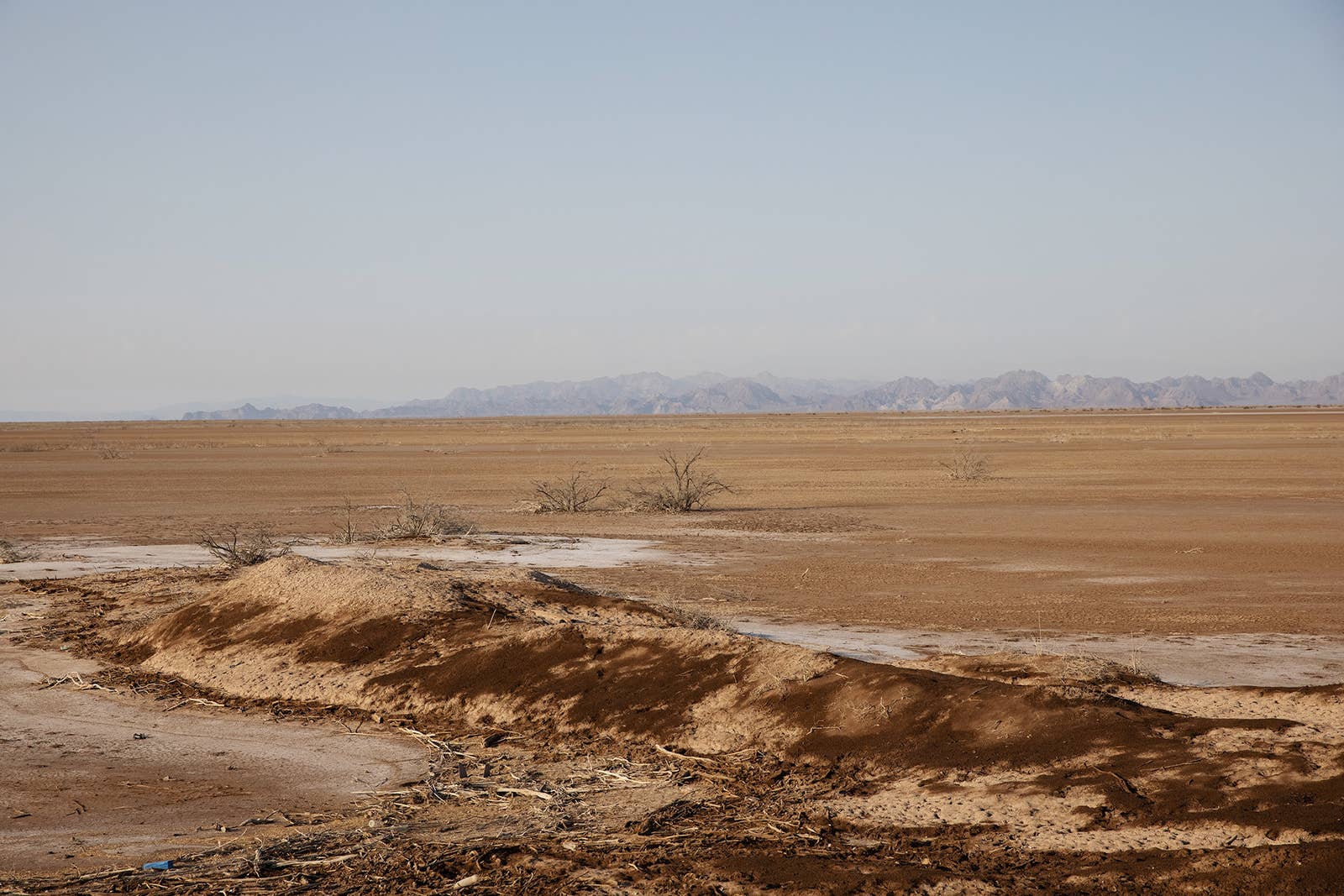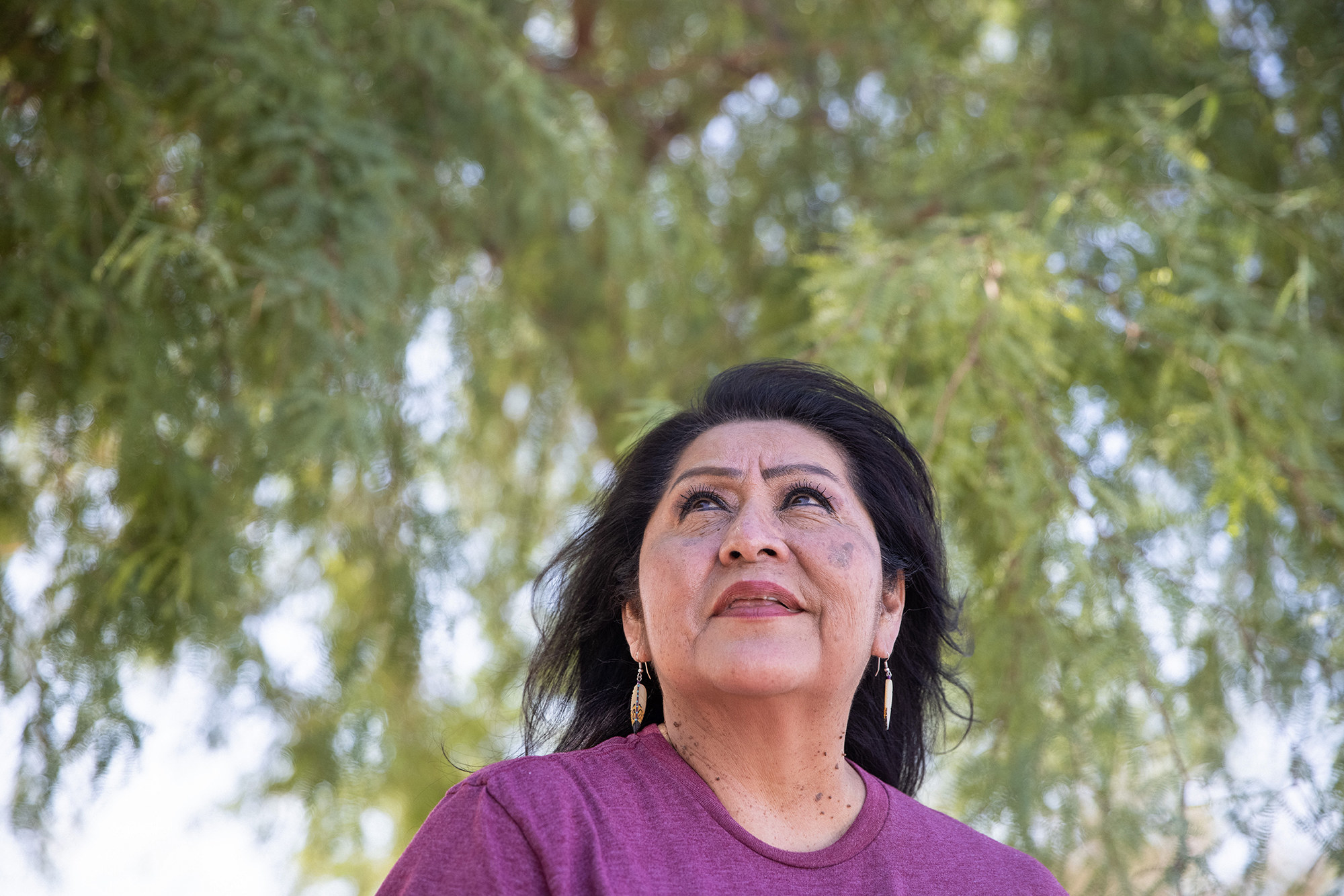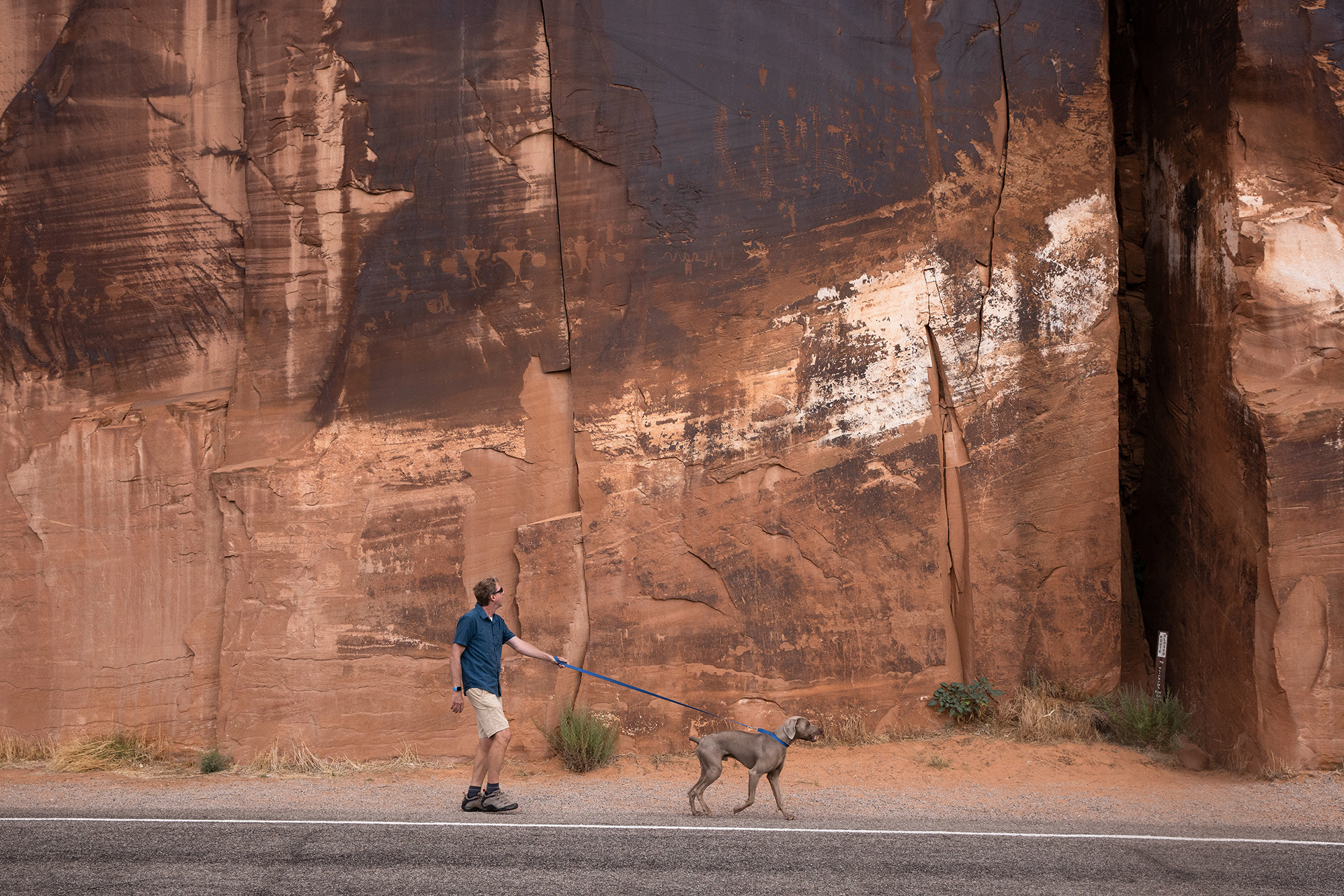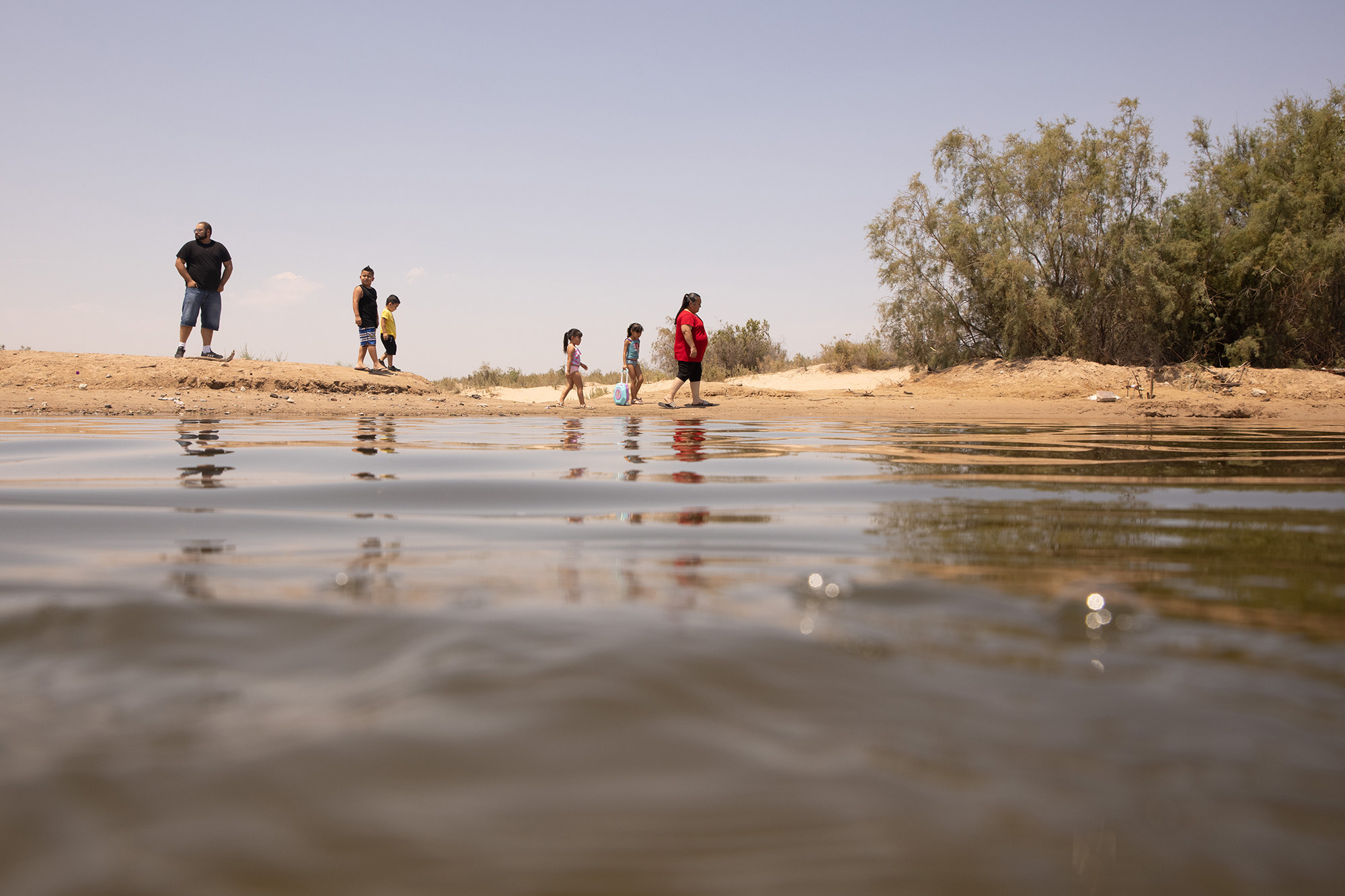
This is Part 3 in a Colorado River Series. For Part 2, click here.
On a 120-degree day, as waves of hot air shimmer above deeply cracked earth, it is difficult to imagine that a hundred years ago this land was part of a vast 2-million-acre expanse of blue waters and verdant trees that formed the delta of the Colorado River. Once robust enough for steamships to cross, the delta supported a thriving ecosystem with thousands of migratory birds and wetland species. Now, a bleached skeleton of a crab is one of the few signs of life remaining.
The delta’s disappearance was the first indication that modern management of the river was pushing the system past its capacity. Starting in the 1930s, construction of major dams and diversions redirected water from the river to reservoirs, farms, and cities from Denver to Los Angeles. By 1960, water stopped regularly flowing to the delta, and over time, 90% of its 2 million acre expanse withered.
“The river is so altered and contained now, I call it a big canal,” said Nora McDowell, who served as chair of the Fort Mojave Tribe for 25 years and actively leads efforts to protect the Colorado River. “This isn’t the river we knew. It used to be just wild. Where I swam, the water was blue and it was clean. It was our playground. … I remember it as a great blue lagoon.”
The Colorado River is now at a tipping point, with implications stretching far beyond its delta. Water levels at the Lake Mead and Lake Powell reservoirs, which depend on snowmelt to feed the river, reached historic lows this year. For over two decades, Western states sharing the river have relied on water from these reservoirs to insulate their residents from feeling the impacts of a relentless 22-year megadrought.

But in August, water levels in the reservoirs dropped low enough to trigger the first-ever federal shortage declaration, which will cut states’ 2022 river usage by billions of gallons. More cuts are likely: 2021 was the second-driest water year on record, and a growing body of data indicates what we are seeing is not a temporary drought, but a permanently hotter, more arid environment and a significantly smaller Colorado River.
Successfully managing water shortages in the short term, while developing solutions for the management of the Colorado River in the long term, is imperative for the 40 million people who depend on its waters. Ultimately, the crisis on the Colorado River is a story about how the United States chooses to adapt to climate change.
Current projections indicating another dry year are “a stark reminder that we need to continue to do more,” Tanya Trujillo, assistant interior secretary for water and science, said at the recent Colorado River water users conference. “In addition to the short-term emergency decisions we will be making, we also need to be very real about the challenge of building long-term solutions in this basin.”
This month, Arizona, California, Nevada, and the federal government announced a plan to temporarily address water shortages. The plan commits $200 million toward projects to stabilize Lake Mead and leave billions more gallons of water in the river through 2023.
Looking ahead, however, a fundamental question looms for those sharing the river: The current drought contingency policies, which govern how the parties share cuts during times of water shortage, will expire in 2026. They were designed to be temporary, but it appears increasingly clear that a drier climate may be a permanent reality for the southwest. So now it must be resolved: What will happen when those agreements expire? And who will make those decisions?

A seat at the table
Since the 1920s, management of the river has been dominated by the seven Western states that signed the 1922 Colorado River Compact. A foundational document guiding how the river is managed, the compact split the river’s water between the “upper basin” states of Wyoming, Colorado, Utah, and New Mexico and the “lower basin” states of Nevada, Arizona, and California.
But it failed to allocate water for the 30 sovereign tribes of the Colorado River Basin (a majority of which have water rights that predate the compact), the northern states of Mexico, where the river ends, or for the health of the river itself.
A century later, with clear evidence of the consequences of these exclusions, the region’s sovereign tribes and conservation groups are pushing for a seat at the table with the states and the federal government as they approach negotiations to set new rules for post-2026 management of the river.
To this day, the basin’s 30 sovereign tribes aren’t formally part of the decision-making bodies governing the Colorado River, despite holding water rights to 20% of its water, an amount greater than allocated to some states in the region.
Daryl Vigil, co-facilitator of the Water & Tribes Initiative, a leading group in the Colorado River Basin advocating for more equitable and sustainable policies, says tribes need an institutionalized way to engage in policy-making. “Without this, we cannot exercise our sovereignty or right to self-determination,” he said.
The basin tribes were not included in 2007 intrastate and federal negotiations to develop the first interim guidelines responding to drought conditions. In 2012, when basin states and the Department of Interior completed a study to “assess current and future water and supply imbalances,” the water usage and rights of the tribes were not adequately considered, leading to a separate study that was published years later.
Despite being marginalized, the basin’s tribes are taking on a leadership role as water shortages have deepened, offering solutions and being among the first water users to contribute water to support critical drought plans.
In 2019, The Gila River Indian Community and the Colorado River Indian Tribes' willingness to conserve water was critical to the success of drought contingency plans. In the recent $200 million deal to conserve additional water through 2023, the Gila River Indian Community and the Colorado River Indian Tribes collectively contributed over a quarter of the water pledged. Yet the underlying framework that currently guides the river’s operations was made without their input.
The basin tribes’ continued involvement in the process depends on executive memorandums and statements of commitment. No legally binding documents or formally established positions guarantee them a place in the bodies that govern the river.
“The [1922] compact talks about an equitable apportionment of water in the Colorado River Basin, but when it was created, my tribe was living on subsistence rations in a place that wasn’t our homeland. So much of the current framework surrounding this river is based on legislation and policy that tribes have had no formal access to,” Vigil said. “You have 30 tribal sovereigns in the Colorado Basin that have lived sustainably here for thousands of years. Why aren’t we including people in the conversation who have known how to live resiliently?”

In a recent letter to Interior Secretary Deb Haaland, leaders from 20 tribes in the basin called on her to ensure tribal sovereigns have a clear role in upcoming negotiations to develop the next framework governing the Colorado River. The letter also announced the creation of a Colorado River Basin Tribal Coalition, where leaders will gather to build consensus on new policies, and asked the Interior Department to encourage states to meaningfully engage with tribes in their internal and interstate negotiations.
Tribal water rights are considered as part of states’ overall allocations of water from the river. As tribes reach water settlements, states have to account for this water from their portion of the river. But with increasing pressure on states to cut existing water usage during shortages, the interests of state water managers do not always align with the interests of the basin’s tribes as they actualize their water rights.
Responding to the tribes’ letter, Haaland wrote that the Interior Department intends to hold “listening sessions” with tribal leadership in 2022. Trujillo, who is tasked with leading that process, said in an interview that the department will incorporate feedback into future negotiations, but she declined to specify if they would formally establish a place for tribal leaders.

As the basin’s tribes push for representation in upcoming negotiations for the river’s future, they are navigating a related inequity — access to clean water.
Despite holding significant rights to the Colorado River, many of the basin’s tribes lack water security. On Navajo Nation, the largest reservation in the basin, 30 to 40 percent of residents lack indoor plumbing and haul water to meet their basic needs. Compared to other Americans, Navajo residents are 67 times more likely to live without access to running water.
“If we look at these issues through the lens of people not having access to water, they are just different aspects of the same fundamental problem," said Bidtah Becker, Associate Attorney for the Navajo Tribal Utility Authority. “Have we separated water issues so far that we no longer see the connection between the shortages of water currently being experienced on the river and the fact that there are people in this basin who do not have access to clean water from that very river?”

Water shortage as an opportunity
Many conservation groups active in the Colorado River Basin view the post-2026 negotiations as a chance to build a management system that’s flexible enough to respond to the impacts of climate change as the river shrinks. With billions in federal funding newly allocated in the 2021 infrastructure bill for addressing impacts of water shortages, Western states have resources to invest in a variety of solutions.
“There are so many things we can do beyond debating water allocations,” said Jennifer Pitt, director of the Audubon’s Colorado River Program. “This is climate change barging through the front door of the Colorado River Basin. It calls for all hands on deck. We cannot get by in the long run with a short-term solution stacked on top of a short-term solution. We need long-term resilience plans and systems thinking.”
Just south of the US–Mexico border, a binational coalition of conservation groups called Raise the River is slowly rebuilding areas of critical natural habitat in the river’s former delta. In the last decade, the coalition has restored over 1,500 acres across several restoration sites with an amount of water that, Pitt said, amounts to less than 1% of the river’s annual flow. According to Audubon’s research, restored sites along the Colorado River delta have species populations that are 80% greater than those of lands not yet restored.
At Laguna Grande, the largest of the sites, dragonflies dart across deep pools ringed by mesquite trees, and desert temperatures noticeably drop under the shade of cottonwoods. Here, it feels possible to imagine how alive the delta once was.
Securing water for the project required building partnerships between the US and Mexican governments, creating a water trust, raising millions of dollars, and passing two treaty agreements. The treaties were the first of their kind in the basin to designate water specifically for nature and the river itself. Pitt pointed to the delta restoration project as an example of how collaboration can benefit people, animals, and the river.
“Rather than being a scary, dangerous prospect to bring excluded parties to table, I think we are actually seeing more parties with a broader solution set willing to think creatively,” Pitt said.
Planning focused on building resilience is increasingly supported by a number of groups. A recent report issued by the Nature Conservancy, American Rivers, Environmental Defense Fund, and several other nonprofits identifies 10 strategies for policymakers to consider as they search for solutions for the Western water crisis. Ranging from the more theoretical, such as ways to slow snow melting, to the well established, such as technology that increases agricultural efficiency, the report proposes a broader approach to addressing water shortages.


Water is life
“Our people were specifically put where we are along these rivers and streams…We are born from water,” said McDowell, explaining the Fort Mojave Indian Tribe’s historical connection to the Colorado River. “The Creator placed us here when he created us. The heartbreak is to see it being misused and seeing it over allocated. Because it is a living spirit.”
The story of the Colorado River is thousands of years old, but we are still very much at the start of the next chapter of its existence — one in which the centrality of water to life, and its deep interconnections, will only grow clearer as scarcity intensifies. The changing climate will become an inescapable fact of life for everyone in the West.
“We have to anticipate that future inflows will be less than [those of] the last 22 years,” said senior water and climate scientist Brad Udall, calling on policymakers to be realistic and develop future management plans based on data, which indicates a much drier future. “When I hear the phrase ‘new normal,’ I actually get a little frustrated. … What we are seeing is not anything related to normal. Normal implies predictability. This climate is not stationary; it is going to continue to change, and people need to plan for less water.”
While progress has been made toward addressing current shortages, it remains to be seen whether long-term agreements on more fundamental changes can be reached in a basin accustomed to incremental policy adjustments — and whether political promises of cooperation and inclusion result in concrete actions.
“Water gives us life,” McDowell said. “People need to start thinking about the impacts of our use of this river from a long-term perspective — not just about how much money this company or person is going to make. If we’re not careful in what we decide, we will cease to exist.” ●
Aerial photography with the help of Lighthawk Flights.


